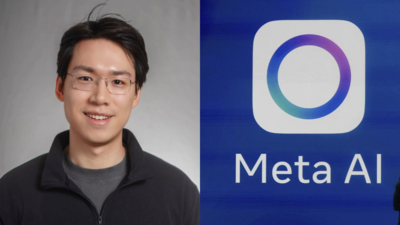AI Research
Enhancing Cybersecurity with Artificial Intelligence: How AI Protects Your Business

As businesses increasingly rely on digital systems and data, the risk of cyberattacks grows. Cybercriminals are becoming more sophisticated, making traditional security methods less effective. Artificial Intelligence (AI) has emerged as a game-changing solution in the fight against cyber threats. AI can analyze large amounts of data, detect unusual patterns, and respond to threats quickly, offering businesses enhanced protection. In this article, we’ll explore how AI strengthens cybersecurity and protects your business from evolving cyber risks.
What is Artificial Intelligence in Cybersecurity?
Artificial Intelligence (AI) refers to technology that enables machines to simulate human intelligence. In cybersecurity, AI uses algorithms to detect, prevent, and respond to cyber threats. AI can analyze vast amounts of data from various sources, like network traffic, user activity, and system logs, to identify potential risks. Unlike traditional cybersecurity tools, which rely on predefined rules, AI can learn from patterns and adapt to new threats, making it a dynamic and evolving defense tool.
AI-driven cybersecurity systems continuously improve by learning from past experiences. As they process more data, they become more effective at identifying new attack strategies. AI’s ability to detect threats quickly and accurately has made it an invaluable asset for businesses looking to protect their networks and sensitive data from cyberattacks.
How AI Protects Your Business from Cyber Threats
AI plays a crucial role in safeguarding businesses by detecting, preventing, and responding to a wide variety of cyber threats. One of the key ways AI protects businesses is through real-time threat detection. AI continuously monitors network activity and analyzes patterns to identify any unusual behavior. For example, if a hacker attempts to access sensitive information, AI can quickly flag this activity and take immediate action to stop the breach before it escalates.
AI also enhances traditional security measures by improving response times. While human intervention often takes time, AI can instantly respond to certain types of attacks, reducing the window of opportunity for cybercriminals. With AI handling routine threat detection and mitigation, businesses can ensure a faster and more efficient defense against cyberattacks.
Detecting Anomalies in Real-Time
AI’s ability to detect anomalies in real-time is one of its most valuable features in cybersecurity. By analyzing network traffic and user activity, AI can recognize patterns of normal behavior and identify deviations from those patterns. If an employee’s account suddenly starts accessing data outside of their typical range or at unusual times, AI can flag this as suspicious and alert security teams immediately.
This real-time anomaly detection can be particularly effective against new types of cyberattacks that traditional security systems may not be able to recognize. As AI systems continuously learn from the data they process, they can adapt to new threats, providing businesses with ongoing protection. The ability to quickly spot and react to anomalies gives firms an edge in stopping attacks before they can cause severe damage.
Automating Threat Detection and Response
One of the most significant benefits of AI in cybersecurity is its ability to automate threat detection and response. AI systems are capable of detecting and responding to cyber threats without human intervention. For example, if an AI system detects a Distributed Denial of Service (DDoS) attack, it can automatically block the malicious IP addresses responsible, preventing further damage to the business.
Automating these processes allows businesses to reduce response times and mitigate potential risks before they escalate. With AI handling routine tasks such as monitoring network traffic and identifying known threats, cybersecurity teams can focus on more complex tasks and strategy. Automation enhances the entire cybersecurity process, making it more efficient and effective by reducing reliance on human input and minimizing errors.
Improving Malware Detection
Malware is one of the most common and damaging cyber threats businesses face. Traditional antivirus software relies on a database of known malware signatures to detect threats, but this method is not foolproof. AI improves malware detection by focusing on behavior rather than just signatures. It can analyze how programs behave and identify malicious activities, such as unauthorized data access or unusual communication with external servers.
AI’s ability to recognize new and unknown malware threats is one of its strongest attributes. As AI analyzes data in real-time, it can spot new malware variants that may not yet be in a signature database. By identifying malicious behavior early, AI helps prevent malware from spreading and causing widespread damage. This behavior-based detection is a more proactive approach to cybersecurity, enabling businesses to stay one step ahead of cybercriminals.
Strengthening Authentication Systems
AI plays a crucial role in enhancing authentication systems, making it harder for unauthorized users to gain access to sensitive data. Traditional password-based systems are increasingly vulnerable to attacks like phishing and brute-force attacks. AI strengthens authentication by incorporating biometrics, such as facial recognition or fingerprint scanning, to verify identities. This adds an extra layer of security that is more difficult for cybercriminals to bypass.
AI also monitors login attempts and user activity to detect suspicious patterns. If an account shows abnormal login behavior, such as logging in from a different location or device, AI can prompt additional authentication methods. This helps protect businesses from unauthorized access and reduces the risk of data breaches. By continuously monitoring and adapting to new security needs, AI ensures that only authorized individuals can access critical business systems and data.
The Future of AI in Cybersecurity
As AI continues to evolve, its role in cybersecurity will become even more prominent. Future AI systems will be able to detect more complex and advanced cyber threats, offering businesses even greater protection. With advancements in machine learning and deep learning, AI will become more adept at recognizing previously unknown threats and adapting to new attack strategies.
The future of AI in cybersecurity also includes increased collaboration between AI systems and human experts. While AI can automate many aspects of cybersecurity, human expertise will remain essential in addressing complex threats and strategic planning. AI will serve as a tool to enhance the capabilities of cybersecurity teams, enabling businesses to develop more resilient and adaptable security systems.
AI Research
Artificial intelligence, rising tuition discussed by educational leaders at UMD

DULUTH, Minn. (Northern News Now) – A panel gathered at UMD’s Weber Music Hall Friday to discuss the future of higher education.
The conversation touched on heavy topics like artificial intelligence, rising tuition costs, and how to provide the best education possible for students.
Almost 100 people listened to conversations on the current climate of college campuses, including UMD Associate Dean of the Swenson College of Engineering and Science Erin Sheets.
“We’re in a unique and challenging time, with respect to the federal landscape and state landscape,” said Sheets.
The three panelists addressed current national changes, including rising tuition costs and budget cuts.
“That is going to be a structural shift we really are going to have to pay attention to, if we want to continue to commit for all students to have the opportunity to attend college,” said panelist and Managing Director of Waverly Foundation Lande Ajose.
Last year alone, the University of Minnesota system was hit with a 3% budget cut on top of a loss of $22 million in federal grants. This resulted in a 6.5% tuition increase for students.
Even with changing resources, the panel emphasized helping students prepare for the future, which they said includes the integration of AI.
“As students graduate, if they are not AI fluent, they are not competitive for jobs,” said panelist and University of Minnesota President Rebecca Cunningham.
Research shows that the use of AI in the workplace has doubled in the last two years to 40%.
While AI continues to grow every day, both students and faculty are learning to use it and integrate it into their curriculum.
“These are tools, they are not a substitute for a human being. You still need the critical thinking, you need the ethical guidelines, even more so,” said Sheets.
Following the panel, UMD hosted a campus-wide celebration to mark the inauguration of Chancellor Charles Nies.
Click here to download the Northern News Now app or our Northern News Now First Alert weather app.
Copyright 2025 Northern News Now. All rights reserved.
AI Research
AI startup CEO who has hired several Meta engineers says: Reason AI researchers are leaving Meta is, as founder Mark Zuckerberg said, “Biggest risk is not taking …”

Shawn Shen, co-founder and CEO of the AI startup Memories.ai, has stated that some researchers are leaving Facebook-parent Meta due to frequent company reorganisations and a desire to take on bigger risks. Shen, who left Meta himself last year, notes that constant changes in managers and goals can be frustrating for researchers, leading them to seek opportunities at other companies and startups. Shen’s startup, which builds AI to understand visual data, recently announced a plan to offer up to $2 million compensation packages to researchers from top tech companies. Memories.ai has already hired Chi-Hao Wu, a former Meta research scientist, as its chief AI officer. Shen also referenced a statement from Meta CEO Mark Zuckerberg who earlier said that the “the biggest risk is not taking any risks.”
What startup CEO Shen said about AI researchers leaving Meta
In an interview with Business Insider, Shen said: “Meta is constantly doing reorganizations. Your manager and your goals can change every few months. For some researchers, it can be really frustrating and feel like a waste of time. So yes, I think that’s a driver for people to leave Meta and join other companies, especially startups.There’s other reasons people might leave. I think the biggest one is what Mark (Zuckerberg) has said: ‘In an age that’s evolving so fast, the biggest risk is not taking any risks. So why not do that and potentially change the world as part of a trillion-dollar company?’We have already hired Eddy Wu, our Chief AI Officer who was my manager’s manager at Meta. He’s making a similar amount to what we’re offering the new people. He was on their generative AI team, which is now Meta Superintelligence Labs. And we are already talking to a few other people from MSL and some others from Google DeepMind.”
What Shen said about hiring Meta AI researchers for his startup
Shen noted that he’s offering AI researchers who are leaving Meta pay packages of $2 million to work with his startup. He said: “It’s because of the talent war that was started by Mark Zuckerberg. I used to work at Meta, and I speak with my former colleagues often about this. When I heard about their compensation packages, I was shocked — it’s really in the tens of millions range. But it shows that in this age, AI researchers who make the best models and stand at the frontier of technology are really worth this amount of money. We’re building an AI model that can see and remember just like humans. The things that we are working on are very niche. So we are looking for people who are really, really good at the whole field of understanding video data.”He even explained that his company is prioritising hires who are willing to take more equity than cash, allowing it to preserve its financial runway. These recruits will be treated as founding members rather than employees, with compensation split between cash and equity depending on the individual, Shen added.Over the next six months, the AI startup is planning to add three to five people, followed by another five to ten within a year, alongside efforts to raise additional funding. Shen believes that investing heavily in talent will strengthen, not hinder, future fundraising.
AI Research
AARP warns of “Grandparent Scams”

MONTGOMERY, Ala. (WSFA) – While artificial intelligence is rapidly transforming our world, a troubling trend shows scammers using it to steal from seniors, specifically grandparents.
You’ve probably heard the phrase ‘seeing is believing’ your whole life. But in an age of artificial intelligence, the turn of phrase doesn’t exactly stand the test of time. When it’s in the wrong hands, this new technology can make our senior citizens, who didn’t grow up in the digital age, a vulnerable population.
“One of the ways we see that being done is with what’s known as the grandparent scam,” Jamie Harding, AARP of Alabama Communications director, said. “The grandparent scam is basically, it usually happens late at night, they’re asleep, and someone calls them purporting to be their grandchild, they’re in trouble, they need money immediately.”
However, it isn’t actually their grandchild on the other end of the phone. Scammers have used AI technology to replicate the sound of their grandchild’s voice to try to take money.
“These are very sophisticated international crime rings, and they have access to a lot of very sophisticated technology,” Harding said.
To protect your family from these scams, Harding suggests having a code word that every member of your family knows so you can be sure it’s actually your loved one calling.
She also advises you not to answer phone calls from unknown numbers and to keep your personal information off the internet.
Not reading this story on the WSFA News App? Get news alerts FASTER and FREE in the Apple App Store and the Google Play Store!
Copyright 2025 WSFA. All rights reserved.
-

 Business1 week ago
Business1 week agoThe Guardian view on Trump and the Fed: independence is no substitute for accountability | Editorial
-
Tools & Platforms4 weeks ago
Building Trust in Military AI Starts with Opening the Black Box – War on the Rocks
-

 Ethics & Policy1 month ago
Ethics & Policy1 month agoSDAIA Supports Saudi Arabia’s Leadership in Shaping Global AI Ethics, Policy, and Research – وكالة الأنباء السعودية
-

 Events & Conferences4 months ago
Events & Conferences4 months agoJourney to 1000 models: Scaling Instagram’s recommendation system
-

 Jobs & Careers2 months ago
Jobs & Careers2 months agoMumbai-based Perplexity Alternative Has 60k+ Users Without Funding
-

 Education2 months ago
Education2 months agoVEX Robotics launches AI-powered classroom robotics system
-

 Podcasts & Talks2 months ago
Podcasts & Talks2 months agoHappy 4th of July! 🎆 Made with Veo 3 in Gemini
-

 Funding & Business2 months ago
Funding & Business2 months agoKayak and Expedia race to build AI travel agents that turn social posts into itineraries
-

 Education2 months ago
Education2 months agoMacron says UK and France have duty to tackle illegal migration ‘with humanity, solidarity and firmness’ – UK politics live | Politics
-

 Podcasts & Talks2 months ago
Podcasts & Talks2 months agoOpenAI 🤝 @teamganassi





















